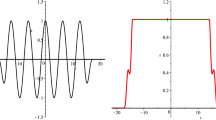Abstract
We study the time-dependent Schrödinger equation (TDSE) with an effective (position-dependent) mass, relevant in the context of transport phenomena in semiconductors. The most general form-preserving transformation between two TDSEs with different effective masses is derived. A condition guaranteeing the reality of the potential in the transformed TDSE is obtained. To ensure maximal generality, the mass in the TDSE is allowed to depend on time also.
Similar content being viewed by others
References
T. Gora and F. Williams: “Electronic states of homogeneous and inhomogeneous mixed semiconductors”, In: D.G. Thomas (Ed.):II–VI Semiconducting Compounds, Benjamin, New York, 1967.
T. Gora and F. Williams: “Theory of electronic states and transport in graded mixed semiconductors”, Phys. Rev., Vol. 177, (1969), pp. 1179–1182.
G.T. Landsberg:Solid state theory: methods and applications, Wiley-Interscience, London, 1969.
O. von Roos: “Position-dependent effective masses in semiconductor theory”, Phys. Rev. B, Vol. 27, (1983), pp. 7547–7552.
O. von Roos and H. Mavromatis: “Position-dependent effective masses in semiconductor theory. II”, Phys. Rev. B, Vol. 31, (1985), pp. 2294–2298.
J.-M. Lévy-Leblond: “Position-dependent effective mass and Galilean invariance”, Phys. Rev. A, Vol. 52(3), (1995), pp. 1845–1849.
L. Dekar, L. Chetouani and T.F. Hammann: “An exactly soluble Schrödinger equation with smooth position-dependent mass”, J. Math. Phys., Vol. 39, (1998), pp. 2551–2563.
Á. de Souza Dutra and C.A.S. Almeida: “Exact solvability of potentials with spatially dependent effective masses”, Phys. Lett. A, Vol. 275, (2000), pp. 25–30.
A.D. Alhaidari: “Solutions of the nonrelativistic wave equation with position-dependent effective mass”, Phys. Rev. A, Vol. 66, (2002), pp. 042116.
B. Gönül, B. Gönül, D. Tutcu and O. Özer: “Supersymmetric approach to exactly solvable systems with position-dependent effective masses”, Modern Phys. Lett. A, Vol. 17, (2002), pp. 2057–2066.
R. Koç and M. Koca: “A systematic study on the exact solution of the position dependent mass Schrödinger equation”, J. Phys. A, Vol. 36, (2003), pp. 8105–8112.
J. Yu. Dong, S.-H. Dong and G.-H. Sun: “Series solutions of the Schrödinger equation with position-dependent mass for the Morse potential”, Phys. Lett. A., Vol. 322, (2004), pp. 290–297.
C. Quesne and V.M. Tkachuk: “Deformed algebras, position-dependent effective masses and curved spaces: an exactly solvable Coulomb problem”, J. Phys. A, Vol. 37, (2004), pp. 4267–4281.
Y.C. Ou, Z. Cao and Q. Shen: “Energy eigenvalues for the systems with position-dependent effective mass”, J. Phys. A, Vol. 37, (2004), pp. 4283–4288.
G. Chen and Z.-D. Chen: “Exact solutions of the position-dependent Schrödinger equation in D dimensions”, Phys. Lett. A, Vol. 331, (2004), pp. 312–315.
A. Jannussis, G. Karayannis, P. Panagopoulos, V. Papatheou, M. Symeonidis, D. Vavougios, P. Siafarikas and V. Zisis: “Exactly soluble harmonic oscillator for a particular form of time and coordinates-dependent mass”, J. Phys. Soc. Japan, Vol. 53, (1984), pp. 957–962.
A. Schulze-Halberg: “Form-preserving transformations of the time-dependent Schrödinger equation with time- and position-dependent mass”, Commun. Theor. Phys. (Beijing), Vol. 43, (2005), pp. 657–665.
F. Finkel, A. Gonzalez-Lopez, N. Kamran and M.A. Rodriguez: “On form-preserving transformations for the time-dependent Schrodinger equation”, J. Math. Phys., Vol. 40, (1999), pp. 3268–3274.
M. Znojil (Ed.): “Proceedings of the 1st international workshop: pseudo-hermitian Hamiltonians in quantum physics”, Czech. J. Phys., Vol. 54, (2004), pp. 1–156.
Á.de Souza Dutra, M.B. Hott and V.G.C.S. dos Santos: “Non-Hermitian time-dependent quantum systems with real energies”, quant-ph/0311044.
G.T. Einevoll and P.C. Hemmer: “The effective-mass Hamiltonian for abrupt heterostructures”, J. Phys. C, Vol. 21, (1988), pp. L1193-L1198.
G.T. Einevoll, P.C. Hemmer and J. Thomsen: “Operator ordering in effectivemass theory for heterostructures. I. Comparison with exact results for superlattices, quantum wells, and localized potentials”, Phys. Rev. B, Vol. 42, (1990), pp. 3485–3496.
G.T. Einevoll: “Operator ordering in effective-mass theory for heterostructures. II. Strained systems”, Phys. Rev. B, Vol. 42, (1990), pp. 3497–3502.
R.A. Morrow and K.R. Brownstein: “Model effective-mass Hamiltonians for abrupt heterojunctions and the associated wave-function-matching conditions”, Phys. Rev. B, Vol. 30, (1984), pp. 678–680.
R.A. Morrow: “Establishment of an effective-mass Hamiltonian for abrupt heterojunctions”, Phys. Rev. B, Vol. 35, (1987), pp. 8074–8079.
J. Thomsen, G.T. Einevoll and P.C. Hemmer: “Operator ordering in effective-mass theory”, Phys. Rev. B, Vol. 39, (1989), pp. 12783–12788.
Q.-G. Zhu and H. Kroemer: “Interface connection rules for effective-mass wave functions at an abrupt heterojunction between two different semiconductors”, Phys. Rev. B, Vol. 27, (1983), pp. 3519–3527.
K.C. Yung and J.H. Yee: “Derivation of the modified Schrödinger equation for a particle with a spatially varying mass through path integrals”, Phys. Rev. A, Vol. 50, (1994), pp. 104–106.
E. Kamke:Differentialgleichungen—Lösungsmethoden und Lösungen, B.G. Teubner, Stuttgart, 1983.
L. Dekar, L. Chetouani and T.F. Hammann: “Wave function for smooth potential and mass step”, Phys. Rev. A, Vol. 59, (1999), pp. 107–112.
Author information
Authors and Affiliations
About this article
Cite this article
Schulze-Halberg, A. Quantum systems with effective and time-dependent masses: form-preserving transformations and reality conditions. centr.eur.j.phys. 3, 591–609 (2005). https://doi.org/10.2478/BF02475615
Received:
Accepted:
Issue Date:
DOI: https://doi.org/10.2478/BF02475615




